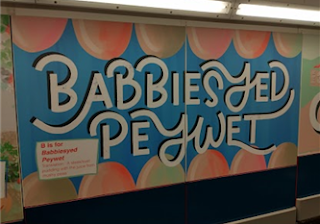Food memories can be some of our most vivid - I’m a Lancashire
lass – I grew up in Wigan. We were definitely a
meat, potatoes and veg family and on a good day with afters (pudding) to
finish.
Of course, up north, lunch was called dinner, and five o’clock onwards was when we had tea – our main meal.
I remember fondly fried breakfasts, readybrek and chopped up egg in a cup at the start of the day. Lunch would be a butty, but if it was a Friday during the school holidays my dad would bring home fish and chips. He was a milkman so worked very early shifts! I was a real meat eater back then – so I’d cross my fingers and ask if I could have steak pudding and chips. I didn’t ever want anything of a kid’s menu and ‘babbiesyed’ as it’s known in Wigan was grown-up food. It won’t surprise you to know I was nicknamed the gannet!
Wigan dialect and food is celebrated in Jess Riley's station art work
- babbiesyed and peywet is steak pudding with pea juice!
(author's photograph)
I also recall the newspaper wrapping, though families would also queue up with pyrex dishes to take home their chippy tea.
Another treat was pie from Edwards Bakery – and better still if I could have it in a ‘barm cake’ – the Wigan name for a bread roll. Wiganers are known as pie-eaters, though the reason why is debated. While Lancashire Hot Pot with a suet crust was another favourite.
My first job was as a reporter on the Ormskirk Advertiser, a small market town in West Lancashire, only a stone’s throw from where I now live. Ormskirk is famous for it’s gingerbread – this sweet treat was made by women in the town since 1732!
Sweet treats
(author's photograph)
Town’s often have their own cake or desert – Manchester Tart, Bakewell Tart, Eccles Cakes and Chorley Cakes – are just a few northern examples.
When I write my stories, I love to include descriptions of food being eaten. In my Gracie Fairshaw series, set in Blackpool, the children devour hot chips outside, with the sea air proving the perfect accompaniment along with lashings of salt and vinegar! In Trouble at the Tower, Gracie enjoys a warm mince pie with cream in the glamourous setting of Blackpool Tower’s Oriental Lounge. While in Kintana and the Captain’s Curse, my heroine has to survive on weevily ship’s hard tack (a not very edible biscuit that pirates ate) and grog and misses the traditional Malagasy recipes her Pa cooks at the pet shop home.
Cook books and food history books and online blogs are a great way to explore what your character would eat, depending on where – and when - they are.
I’ve found some fantastically useful titles over the years, including while researching what people ate in 12th century Cambodia during the Khmer Empire, the Incas in Peru and the Congo at the beginning of the 20th century.
It’s even better if you can try the foods for yourself – though you may need to watch your waistline!
Our tastebuds can transport us to other places and times – though there are some childhood snacks I wouldn’t want to try again – 1980s blackcurrant flavoured crisps being one!
(All photos: Susan Brownrigg)
ACTIVITY
It's time to go shopping! You are looking for foods that your character would eat - it could be sweets, something savoury or a dessert! Buy a couple that look interesting - but remember to check the ingredients if you have any allergies/dietary requirements!
Back home - find some paper and a pen or pencil. When you're ready, find a quiet spot to eat your food. Don't rush! Let the flavour fill your mouth, what is the texture like? How does the food make you feel? Is it a taste you like, or not?
Where would your character eat this food? At home? In a cafe? On a picnic?
Jot down these thoughts and try to form a scene from them.
Is your character eating alone or are they with friends, family, an enemy?
Are they savouring every mouthful or in a rush? Mood can affect how we feel about what we eat too.
Perhaps you could create your own recipe using local produce! Think about what ingredients you would use and how it would be cooked.
Author Susan Brownrigg
Susan Brownrigg is a Lancashire lass and the author of three historical children's books for ages 8+ - Gracie Fairshaw and the Mysterious Guest & Gracie Fairshaw and the Trouble at the Tower are seaside mysteries set in Blackpool. Kintana and the Captain's Curse is a pirate adventure set in Madagascar.





